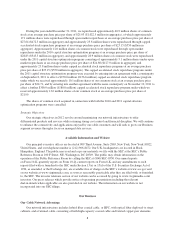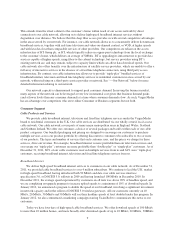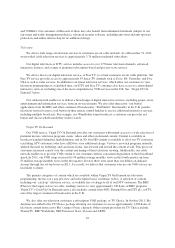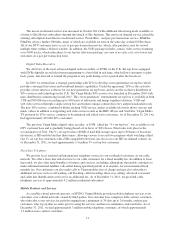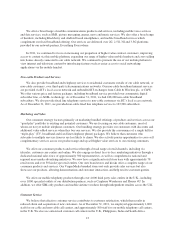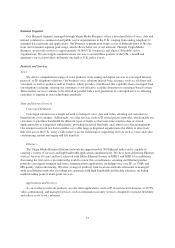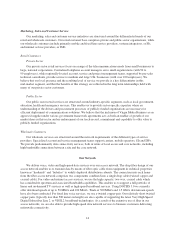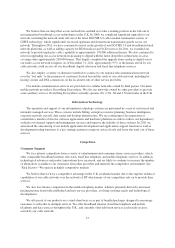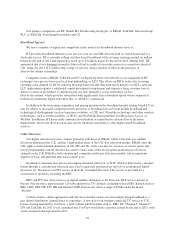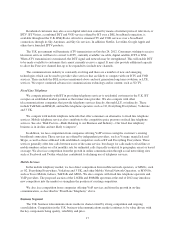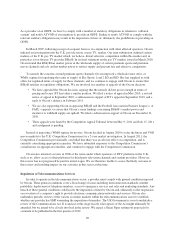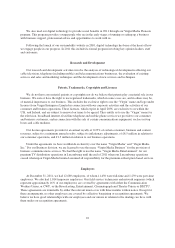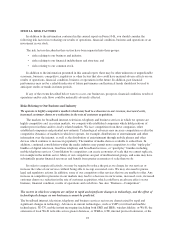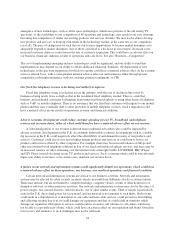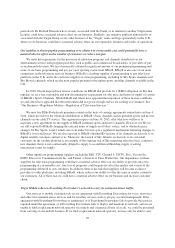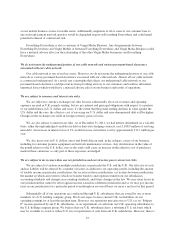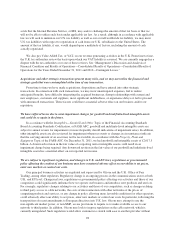Virgin Media 2011 Annual Report Download - page 19
Download and view the complete annual report
Please find page 19 of the 2011 Virgin Media annual report below. You can navigate through the pages in the report by either clicking on the pages listed below, or by using the keyword search tool below to find specific information within the annual report.Virgin Media Business competes primarily with traditional network operators such as BT and C&W. BT
represents the main competitive threat nationally due to its network reach and product portfolio. We also
compete with regional providers, such as COLT Telecom Group plc, which have a strong network presence
within limited geographic areas. Recently, we have faced increasing competition from services provided by
MNOs which target small business customers.
In the retail market our traditional competitors are becoming increasingly focused on particular segments of
the market. For example, C&W targets larger national and multi-national corporations. We continue to focus on
small, medium and large nationally oriented businesses and public sector organizations. System integrators, such
as Kcom (formerly known as Kingston Communications (Hull) Plc), are also becoming an increasing competitive
threat as large organizations continue to focus on IT integration, management and outsourcing.
Seasonality
Some revenue streams are subject to seasonal factors. For example, fixed line telephone usage revenue by
customers and businesses tends to be slightly lower during summer holiday months, mobile customer acquisition
and retention costs generally increase in the fourth quarter of each year due to the Christmas period, and mobile
average revenue per unit, or ARPU, generally decreases in the first quarter of each year due to the fewer number
of days in February and lower usage after the Christmas period. Our consumer cable churn rates include persons
who disconnect their service because of moves, resulting in a seasonal increase in our churn rates during the
summer months when higher levels of U.K. house moves have traditionally occurred and when students leave
their accommodation between academic years.
Regulatory Matters
Overview
Legislative Framework
Our business activities are subject to the laws and regulations of the European Union, or EU, and the U.K.
At an EU level we are regulated by the “European Framework” which applies to all communication
networks and services for electronic communications including telecommunications (fixed and mobile), e-mail,
access to the internet and content related broadcasting. The purpose of the European Framework is to ensure
more effective competition leading to better rights and options for consumers. The European Framework
comprises:
• Directive 2002/21 on a common regulatory framework for electronic communications networks and
services;
• Directive 2002/20 on the authorization of electronic communications networks and services;
• Directive 2002/19 on access to, and interconnection of, electronic communications networks and
associated facilities; and
• Directive 2002/22 on universal service and users rights relating to electronic communications networks
and services.
These directives are supplemented by EU Directive 2002/58, concerning the processing of personal data and
the protection of privacy in the electronic communications sector.
In the UK the European Framework is implemented through the Communications Act 2003, or the
Communications Act, which regulates all forms of communications technology, whether used for
telecommunications or broadcasting. The Privacy and Electronic Communications Regulations 2003
implemented EU Directive 2002/58.
18


